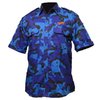just avoid the blue end of the spectrum.
to animals, blue looks like s white shirt under a disco light.
keep still, don't skyline, and don't wear perfume.
bruce.
Zarco™ Safety Camouflage – Ideal for hunting or security clothing. Increase your visibility to other hunters while you remain inconspicuous to animals such as antelope, deer and buck. As with most modern camouflage materials available today, the profile of the hunter is scattered against the natural background however Zarco™ Safety Camouflage patented vision deception technology ensures that you can enjoy the benefits of getting really close to your target while at the same time reducing the risk of being mistaken for game by other hunters.
Zarco Safety Camouflage was developed by a team of experts involved in the design of advanced military camouflage technologies – resulting in the creation of a patented hunting safety camouflage which increases the visibility of the hunters profile to humans while at the same time remaining inconspicuous to animals such as deer, antelope and buck. The vision deception technology employed in the camouflage design exploits the differences in the structure and spectral response of the animal eye when compared to the human eye.
Animals with dichromatic (color blind) vision such as hoofed animals which include deer, buck and antelope species look at the environment in a completely different way than humans do – therefore we do not have to try and hide away from other humans in the bush but rather maintain a high visible profile to other hunters, thereby increasing overall hunting safety.
Zarco Safety Camouflage’s vision deception technology takes care of the rest – the hunter profile is scattered against the natural background ensuring that the hunter continue to enjoy a competitive advantage.
ZarcoTM Safety Camouflage is also visible to colour blind hunters
The prevalence of colour blindness (dichromatic vision) in the human male population is estimated at around 8%. With millions of hunters in the United States alone, there are a substantial number of hunters who are unable to distinguish red and green from the natural background environment, or see red and green differently from people with normal tri-chromatic vision.
Many of these colour blind hunters are also unable to recognise colours such as blaze or hunters orange and would perceive them as shades of yellow or tan against the natural background.
Very few men (< 1%) are unable to see the colour blue. Therefore, blue would be a logical choice to increase the visibility of the hunters profile to the overall human population. Zarco Safety Camouflage therefore increases hunter visibility to a greater percentage of the hunting population.
Where legislation requires the use of Hunters Orange, you can wear this together with Zarco Safety Camouflage, that way you get the best of both worlds and increase your overall visibility against the natural background.
Human vision VS. animal vision
How is the human eye different to the animal eye?
The human eye
The human eye has three types of cone receptor cells present in the retina which is known as tri-chromatic vision. These cone receptor cells are situated in a small area of the retina known as the fovea and allow us to have highly focussed and exquisite colour vision. Cone receptors function primarily during daylight conditions and therefore we are able to receive and interpret millions of colour signals during the day.
A second type of photoreceptor is present in the human eye which is known as rods. Rods are responsible for detecting the luminosity (brightness) of light and are used primarily during low light conditions. Due to the absence of rods in the fovea, humans generally have no colour vision during night time.
The animal eye
In contrast, the animal eye has only two sets of cone receptor cells which are also referred to as dichromatic vision. Due to vast differences in the animal eye structure when compared to the human eye, these cone receptor cells are scattered across the entire retina which spread their daylight vision in all directions with no focus on any particular zone. Also present in the animal eye are rod receptors. These receptors function mainly during low light or night time conditions while the cone receptors function during daylight hours.
The animal eye also has a light reflecting layer situated at the back of the eye which allows its receptors a second chance to absorb light. However, this reflecting layer also causes blurred vision during daytime conditions. The bigger eye with a rectangular aperture forfeits sharpness while trying to compensate for the large amount of incident light.
The cones and rods are connected to neurons which feed visual images to the brain. In the case of animals, large quantities of receptors are connected to the same neurons which increase sensitivity with a loss in high definition colour vision.
Due to these differences in eye structure as well as the different distribution ratios between cones and rods in the human and animal eyes, deer, antelope and buck do not have the same colour acuity as humans do and therefore have very limited colour vision.


